Hello, I'm new here. I just bought an OpAmp Labs mixer at a garage sale for $50. It's the 8 channel version of the 1204-tv. I'm not sure of the model #, but the preamps and eq sections are the same as the 1204. I saw one selling on ebay for about 100 times what I payed! Can anyone else tell me more about this piece? thanks!
Comments
24 track Scully? forasong, post: 347789 wrote: I have a full op
24 track Scully?
forasong, post: 347789 wrote: I have a full op amp 24ch studio board wired into a Skully 24 track 2in tape unit. (have 2 Skully 24 track machines) cant wait to get these all into the new studio and try it out.
Those must be customized Scully 2" 24 track machines? Scully never made anything more than a 16 whether it was the 288-16 or the model 100-16. And what do you do for a 24 track Sync Master? Those machines can't fully erase any of the most recent hot tapes from Agfa/Ampex/3M or any of the new permutations. But it can certainly erase Ampex 456 Scotch 226 but not the Ampex 499 Scotch 250 Agfa 468. You just can't get a full depth of erasure. Beautiful sounding machines if you stick with the older tape formulations.
Scully freak
Mx. Remy Ann David
yes 2 24-track skully 2in tape machines...one is for spare parts
yes 2 24-track skully 2in tape machines...one is for spare parts but as it sits it all works, one was the main deck.
These were custom made I was told, i will post some pics sometime of them.
Oh and Moonbaby, dont know what that comment is for but if ya want to be an ass I guess thats your option.
Yeah, well I've been called worse before, and probably again in
Yeah, well I've been called worse before, and probably again in the future. Remy was a lot more tactful than I was, and that in and of itself is a blessed event:) But let's face it; your very first post here and you claim that you have not 1, but 2, machines that the manufacturer says they never made. BTW, I believe that Remy worked for SCULLY...and you did not answer her technical questions, all you did was get snotty about my ribbing you for not spelling the manufacturer's name correctly.
FWIW, in 1977, when I was planning to expand my 8-track room to 24 tracks, I looked at (3) machine manufacturers:
Ampex (already owned a couple of AG-440's to mixdown to)
MCI (another studio here had a 16-track )
Scully (because of Tom Scholtz and Boston)
We nixed the Scully because the factory told us that they didn't make a 24-track machine, and that they were not interested in building one. Whoever we talked to back then ran off a litany as to what
technical issues would be involved to pull this off. No way was I going to compete without a 24-track, period.
The Ampex was a lot more $$ and the sales guy was a schmuck in a suit. So we went with Jeep Harned's JH rig and never looked back.
Enjoy that rig, guy!
And here is a funny story when we were looking for a multitrack
And here is a funny story when we were looking for a multitrack machine for our new studio. We realized that we were not going to go 24 track but rather 16 track 2". I went up to NYC to look at a couple of MM 1000-16 machines. One at Regent Sound Studios. I was shown the machine during a tracking session while it was in record mode. I couldn't see the singer in the band but it sure as heck sounded like Robert Palmer? When walking down the hall with Bob Loftin (the owner) I told him that guy sounded like Robert Palmer? He told me, " it was Robert Palmer". We opted not to get that monster. Instead, we purchased a brand-new MM 1200-16 that was on display, on the floor, at the AES at the Waldorf Astoria in 1978. We ordered 8 of their PURC cards (Pick Up Recording Capability). This was a significant option. In times gone by, when you punched in to record and then dropped out, there was both an overlap & a gap because of the difference in distance between erase & record heads. This made some punching impossible. But if you had the pickup recording capability without overlaps & gaps, you could punch like nobody's business. Unfortunately, the Ampex cards would not function without significant pops & clicks being introduced to the recording! Ampex didn't believe me when I told them their lousy cards didn't work. So they sent out a couple of senior factory technicians. These guys worked on the machine for 2 days only to take out their PURC cards and reinsert the originals. They said that their card had worked in the AG 440.??? So, I guess we were the first to try and purchase multiple cards for a MM 1200 which wouldn't work. No fix either. So we never had that feature on our MM 1200. I couldn't have produced the jingles I did down in Florida without that MCI JH-110A-8 because their pickup recording capability punch in WORKED! And it allowed me to to do things that couldn't be done until we got our computers 15 years later.
And yes, I worked for Scully as their QC manager/final test technician and the primary troubleshooter on the 280B problems after the company was purchased from Dictaphone. I was there for less than a year before I decided to move on and they went belly up being purchased by Sequoia Electronics in Colorado. I still have a few sitting around.
Old analog like old engineers belong together
Mx. Remy Ann David
Well you dont need to believe me, thats your choice and just bec
Well you dont need to believe me, thats your choice and just because it was my first post here makes me a liar? wow with that kind of attitude it is a wonder anyone posts here.
I never questioned anyones background on here either, I got these machines, I did nt say I was an expert with them. Hell, I dont actually know much about them at all I was actually hoping to learn more not get called a liar.
Anyway, think I will move to a more helpful board.
God speed
I never called you a liar....you are certainly no speller :) So
I never called you a liar....you are certainly no speller :)
So you've got not 1 but 2 Scully 24-track machines, 1 in use and 1 for parts, great !
And you don't know much about them, so this is definitely the place to learn. After all,
Remy is chock full of great tech information on them, probably the most knowledgeable
in the country (if not the world) for Scully machines. Don't let ME keep you from obtaining that information, we all want to see analog kept in operation.
I'm certainly not trying to scare you off. I was only indicating
I'm certainly not trying to scare you off. I was only indicating that Scully never manufactured anything more than a 16 track machine. You indicated these were customized which is entirely possible. I've never seen one much less two. They are great machines. The Op-Amp Labs console is a terrific piece of early 1970s technology. Bel Los Mandy was one of the early fathers of integrated circuit technologies. While there were some usable IC chips back then few sounded as good as his 4009 op amp. He coupled that with additional output buffer transistors, input transformers, etc. into these fine little 8 Gold plated pin tube sockets. They had nice ferrite core inductor equalizers of which they had 2 different models. Their earlier model only offered shelving equalization at a few selectable frequencies. Their later equalizers offered bell shaped midrange frequency selections with high and low frequency shelving. Although some folks don't like those little Beyer microphone Transformers which is what he used in the 360BM/M preamps. The BM were slightly lower in noise but also have less output drive capability than the M preamp. So if you wanted to feed an Ampex or Scully and you didn't have the entire console you would want 360M preamps, since they could drive 600 ohm loads quite nicely. Just not as much of an issue with today's stuff that have 10,000 ohm or greater inputs. Just like API, Neve, Auditronics, these consoles while limited in their features could be considered of a boutique vintage quality piece. They used a bipolar 24 V supply unlike most of the other consoles. Most of the others utilized a bipolar 15 V or single polarity 24 V. So this console could swing 48 V on its rails which probably few people know. Although there were complaints about overload by folks that were utilizing factory built consoles. You could build your own from a box of parts if you wanted to. That's what I did but I utilized some different gain staging which I feel really improved the headroom we achieved with our console. Sure, my board was probably running a few DB more noise than the factory unit. But since we were aiming at the rock 'n roll market, that's really not a factor if you know what you're doing. The analog tape machine generated more noise than the console so it's really moot. I didn't use his output transformers but instead UTC A- 20's if memory serves me correctly. My output & monitor section was completely custom. I built the console so that it could also be expanded to 30 inputs but that but that never happened. Back in 1978 I spoke to Bel quite a number of times. For that matter, back in the day, I never thought twice about contacting a person or manufacturer of a piece of equipment to discuss their philosophy & maintenance concerns on their product. In fact, that's one of the ways I ended up becoming Scully's QC manager/Final Test Tech. When someone figures out you know their equipment better than they know their own, it's an employment prospect. And with the gear you have, you're going to have to get into the thick of it to keep it going and good sounding whether it's for yourself or for prospective clients. You might be working this stuff but I can assure you it will work you. Of course, I might be talking to myself and you're probably not here?
I love to talk shop to myself. Really? Yup. I'll never forget when the take-up reel motor smoked on my used Curtis Mayfield JH 10-16. The next day it functioned like nothing happened...
Mx. Remy Ann David
Hello, There have been many excellent collections of op-a
Hello,
There have been many excellent collections of op-amp circuits in the past, but all of them focus
exclusively on split-supply circuits. Many times, the designer who has to operate a circuit from a
single supply does not know how to do the conversion.
Single-supply operation requires a little more care than split-supply circuits. The designer should
read and understand this introductory material.
thanks!!
______________
[[url=http://[/URL]="http://www.discount…"] buy cables online [/]="http://www.discount…"] buy cables online [/]
Ok I am back, Sorry I just picked all this gear up...my mistake,
Ok I am back, Sorry I just picked all this gear up...my mistake, it was 2 16ch Skullys and a OpAmp studio board along with many other things like bunch of Gainbrain comps and Kepex limiters and a AKG BX5 spring reverb unit. I do not know much about this stuff but am hoping to get some help with it and get it up and running in the studio. I have all manuals, schematics and such for all the gear.
Here are some pics, they are crappy and the gear needs some cleaning but here ya go. I also have 2 boxes of extra new mic pres and plug in parts for the OpAmp board.
I would love any help I could get, thanks all.
Welcome back. Maybe. Since it was mentioned to you on your first
Welcome back. Maybe. Since it was mentioned to you on your first pass, I'll start here with it on your second. Please, go out to the garage or wherever you are storing this gear and look at the nameplate on the recorders. Notice it says "SCULLY" without a "K"....not "Skully". Just wanted to get that out of the way.
Now hopefully, Remy will get with you on this collection of stuff and help you out. It wont get any better than that source of information so dont get defensive and all out of shape when someone simply wants to correct you and get you going down the right path.
Love the Kepex's BTW as well as the AKG reverb. But then I'm old school too......Still have the OLD Allison badges!!!!
peace.....(remember, you own SCULLY tape recorders)
yes Remy was right. I was told before I saw them that they were
yes Remy was right.
I was told before I saw them that they were 24ch machines, though I am very happy with them being 16ch, either way works for me. Sorry I keep spelling Scully wrong, wont happen again.
There was a bunch of other gear as well including many new rolls of Tape and some very cool old keyboards. I am hoping we can get on the right track this time, thanks for the info on the gear all.
OMG! Yup, you hit the mother lode! It's obvious that you have a
OMG! Yup, you hit the mother lode!
It's obvious that you have an early release Scully 288-16 actually made in Bridgeport before the Dictaphone purchase of Scully. That particular machine is the finest sounding of the Scully 280 series. Most of the silver faced electronics indicates Bridgeport Connecticut manufacturing. If they were beige, it would indicate a Dictaphone built machine. And to make sure that this is not been modified to the later, newer silicon transistors, pull out any of these circuit cards from the electronics. Look for the transistors. If you find little black & silver metal cans with GE imprinted, you have the original germanium transistors. If the transistors are black, smaller all epoxy/plastic transistors, it has been modified. This modification also required changing other prerequisite resister's since the voltage drop for geranium transistors is different than that of silicon. Many boutique microphone preempts today utilize germanium transistors. So what you have there is 16 channels in the Scully of unique boutique microphone preempts.
Now onto that Op Amp Labs console. Wow! Looks almost identical to the one that I built in 1978. These were early integrated circuit chips that actually sounded quite tasty. The equalizers while being somewhat limited utilize lovely ferrite core inductors and are quite NEVE like. I still have the master section & 10 inputs from my 20 input console I built. So between your Scully microphone preamp's and the Op Amp Labs desk, you've got an incredible sounding facility.
Yup, I still have 8 of those Allison Research KEPEX's in the control room. They only chatter if you do not understand how to utilize them properly. Threshold, release time & proper setting of just enough downward expansion generally solves the chatter problem. I never cared much for their Gain Brain comp/limiter but that was probably due to my own operator error? But between those & the KEPEX's (or should that be KEPEX' ? English grammar was never my best subject) you have some fabulous drum processing in the making. I usually used UREI 1176's followed by the KEPEX as my favorite way to process much of a drum kit. Plus your KEPEX' when utilized for only 10 to 15 of downward expansions makes for some quite effective tape track noise reduction and didn't have quite the same dulling effect that Dolby A imparted upon the sound of the tape. Of course the KEPEX was essentially an early, all transistor VCA. So there is a slight mush like quality that you will find from the KEPEX. One of the biggest problems you'll find with the KEPEX is probably the need to replace every electrolytic capacitor on every one of those KEPEX & Gain Brain cards. Otherwise, if you don't, they won't work worth a damn. Looking at the colored knobs indicates these were the later release of the Brains & KEPEX'. The earlier version (original release) utilized aluminum knobs and all of the visual indicators were neon bulbs. This required the power supply to have an additional 100 V circuit to make the neon bulbs work. A later upgrade could be made to LEDs which I had to do to 4 of my 8 but you already have the LEDs.
My friend you have one heck of a classic sounding boutique control room where the balls, rather than the sky are the limit! You'll make great recordings with what you've just gotten. The console sounds as beautiful as any API or NEVE of the same late 1960s era. Totally Awesome!
Now here's the really exciting part. Since most of us have to incorporate some kind of digital technologies within our recording systems, all you really need now is a used Alesis HD 24xr (or stock HD 24). You'll only need 2 roles of 2 inch tape. When you start tracking your sessions, you should provide headphone fold back through the Op Amp console. But at the same time, you'll be rolling to the 288-16 in record/repro mode. The output of which will be sent directly to the HD 24. That's the ticket! Overdubbing will require a little more tricky time displacement realignment which will require a little imaginative thinking OTB.
One of the other things you should know about the 288-16 is that the "linearizer" adjustment should be completely disabled utilizing any modern day recording tape. The linearizer was designed to create an inverted distortion element that would gain you 2 DB of additional headroom or lower noise level. It is not applicable to any modern-day recording tape. To disable the linearizer the adjustment control must be turned fully clockwise and not counterclockwise. It's a common mistake made by many. You can verify that the linearizer is not in operation when feeding the machine and a 1 kHz sine wave at 0 DB. When you press the momentary recessed red pushbutton, the playback level should not change. It shouldn't go up, it shouldn't go down. If it does, the linearizer adjustment control may have been reverse wired since lots of people had issues of turning it off by turning it up.
There can be additional problems with certain situations involving the last series of super hot recording tape such as Scotch 250 and it's Ampex & Agfa cousins. Without extensive wiring modifications the hotter tapes do not fully erase which will leave audible garbage behind. So for convenience of operation, one shouldn't use anything other than Scotch 206/226, Ampex 406/456 (I can't remember the Agfa tape model number that'll work?) These will yield the best results with the 288-16's, 284/280's series. I believe that the "Wolke" full width " Staggered Gap" erase heads will allow full erasure with the latest hot state-of-the-art recording tapes. Other folks have indicated that a replacement of the erase head wiring with a much heavier gauge conductor can improve erasure with the original NORTRONICS erase head but I have not personally verified that. So if you're not going to worry about erasing anything or doing overdubs on the 288-16, you can use the hotter tapes even though your bias adjustment will be " balls to the wall" to make that happen.
The noise adjustment on the 288-16 provides a small DC offset in the recording circuitry to the head. This can help eliminate some of what we called " bias rocks". This is best done when feeding the machine in a very low frequency i.e. 30 Hz sine wave. Monitoring on playback while recording, you can adjust the noise adjustment to reduce the rocks or gravel like sound. But this is also dependent upon bias level as well. Normally, most folks would over bias by 2 DB at 10 kHz which was pretty darn close when utilizing Scotch/Ampex 206/406 tape. Conversely, the John Stephens method of utilizing a 10 Hz sine wave function generator while clobbering the tape fairly aggressively & listening to playback and adjusting bias for lowest modulation noises & rocks makes for much smoother bass response and is generally equivalent to +2 DB over at 10 kHz. Of course, it's only my personal preference that I like rocks with my Scotch, if I am a Dewar or the Glenlivet. Of course R&B goes well with J&B. Of course if you want to enjoy the finest sound with your beverage, you might want a Remy'?
What have I forgotten? Oh yes! The shot glass effect!
Mx. Remy Ann David
I hope some of you younger enthusiasts of vintage sound read thi
I hope some of you younger enthusiasts of vintage sound read this. If you insist on using a tape machine, THIS is the way to do it. The only pass the heads will see is the intial recording pass with the output to the converters and direct to a harddisk or PT or whatever DAW you like. The bias and alignment will only have to be for the type of tape you can find easily and the desire for that big clear compressed sound will be there for the money.
Talk about a hybrid system!!! This methodology will work with ANY size/speed/track number tape equipment.
Glennfiddich, neat and old enough to vote.
WOW Remy, So much amazing info on this gear, and yes I am pretty
WOW Remy,
So much amazing info on this gear, and yes I am pretty sure they are the earlier machines (I will check when I can). I have all the schematics, operator books and many extra parts as well for all the gear.
I have a studio here in Washington but not alot of room for this stuff but my wife and I are talking about opening another studio at our place outside of Portland, OR.
At that time I might need someone to really help me set this gear up in the best way and maybe a bit of training as well. If you do that sort of thing please let me know or if you know someone I could contact send me an e-mail.
This stuff really needs to be gone through and cleaned as well, any pointers for that?
Also, I was told this came out of a studio up here by the boarder called "The Barn" and had recorded many artists such as Brian Adams and some BTO but that is all I could find out on its history.
Thanks again, wish me luck :)
Here are a few tips on machines. From your pictures, the one wi
Here are a few tips on machines.
From your pictures, the one with the silver colored electronics is your best sounding, most classic sounding machine. The one with the beige painted electronics are the silicon/Los Angeles built, quieter but with less character machine. It would also appear that you have an intact Sync-Master and one with with a homebrew custom version on the older machine. The rubber pinch roller will be the most likely deck plate mounted item that will need replacement. There really aren't any good other methods to resuscitating pinch rollers. I don't recommend any chemicals with the label " rubber rejuvenator". The aluminum deck plates clean up very nicely with Fantastic Spray Cleaner from SC Johnson (a family company).
The brakes on Scully's hard disk style and should not be tension too tightly or too loosely. These breaks are not exactly designed to stop the machine from high-speed shuttling modes. They are really there to stop the tape if the tape breaks, which it won't since it ain't acetate anymore but Mylar/polyester. Ampex utilized a drum style braking system.
The electronics will require that you replace most all electrolytic capacitors that have polarity indicators of + & -. The other capacitors not indicating any polarity generally do not need to be replaced. It may seem like a daunting task but believe me, this is the most worthwhile fix up for any decent electronic circuits. Lower noise, better frequency response, more stable operation can usually be expected. Because of the age of the units, input/output & equalization & bias controls may well be noisy & intermittent. Some spray contact cleaners can sometimes help these things. Unfortunately due to their age and many of them are sealed, they're difficult if not impossible to clean properly/adequately. Sometimes you can live with some of these, sometimes you can't. Thankfully, many of these machines on their input and/or output volume controls have a, what appears to be an off click switch. This simply allows an internal potentiometer to set the calibrated input/output levels. Or, one can utilize the front panel lion controls to set them to something other than the calibrated potentiometer. So you really have 2 different input/output volume controls. A simple maintenance workaround where some will be used in their calibration positions and others will be set by the large knob front panel. It's no big deal. Other controls such as the screwdriver set will be more awkward to deal with due to their smaller size & chassis mounting. Make no mistake, the "linearizer" adjustment should be set to the full clockwise position to disable that circuit. That device & that circuit was truly only designed for Scotch 111 which was the original standard tape. Tapes that were newer formulations, lowering noise, higher output cannot take advantage of what the linearizer was designed to do. In fact, it can actually make your recordings worse off if you do not disable it. It's just confusing to disable that because disabling means full clockwise not full counterclockwise.
Specially produced reference calibration playback test tapes are required for proper alignment procedures. These freaking calibration tapes are extremely expensive. MRL labs makes/made some of the best. At one point, Jay McKnight came up with a more bargain oriented playback alignment tape that had less of a broad frequency playback compilation. He only utilized the most used critical frequencies to shorten the product. These would be 100% adequate for your purposes. And you'll save lots of dough considering this is also a dual speed machine of 15 IPS & 30 IPS. Of course many things were customized back then and the possibility does extend to 7.5 IPS & 15 IPS since some of these machines were utilized to produce " loop bin" master for high-speed industrial grade duplicators for products such as 8 track cartridges for the player in your car. But they didn't used to use 2 inch machines for that but generally 1 inch 8 track. That doesn't mean that your machines didn't have replaceable tape guides & different head stack blocks. Those were modular enough and frequently were changed back & forth on a regular basis, as needed.
Because these heads were longer from top to bottom than their 1/4 & 1/2 inch brethren, not only do you have to be concerned with azimuth (the left to right tilt) of the head but you will also encounter " wrap". That is the circular positioning. Too far to the left or too far to the right will not put the gap squarely in contact with the tape. And then there is the more elusive zenith adjustment. The Zenith adjustment really has to be made utilizing a grease pencil also commonly referred to as a "china marker". The grease pencil is then scribbled to completely cover the heads from top to bottom. Then you put a piece of inconsequential tape on the machine. You roll tape for a while (a couple of minutes). Carefully removing the tape you then observe the face of the heads. The tape should have worn off some of the grease pencil marker. This will reveal a vertical wear indication. You want to make sure that the vertical wear indication appears to be a perfectly straight line on both sides of the wear marks. You don't want to see it skinny at the top & fat at the bottom or vice versa. This would indicate that the front or back head adjustment screw is pushing the bottom of the head forward or pulling it back causing the top of the head to push forward. This will cause serious uneven headwear. And this is an eyeball only adjustment. MCI/Sony once came up with a series of special alignment anodized aluminum blocks for this adjustment. Unfortunately those blocks even if obtainable are not applicable in use on the Scully's. But I did like that concept. It still required eyeballing but I believe it provided for a slightly easier method that looks to be more professional in its execution than being like a child with a handful of Crayons. You need to keep up a professional image you know. Thankfully, these are not adjustments that have to be done much more than when heads are replaced or reconditioned/relapped. One of the important wear out indications on heads is how deep the tape has cut a groove. I wish that last sentence had something to do with the music recorded upon the machine but it actually means that the tape, over a long period of time, acts as a wonderful metal file. The worse the grooves, the more damage it does to the tape. However, grooves do not mean that the heads need to be replaced. This precise scenario was considered during manufacturing. They made the pole pieces of the heads thick enough so that the heads could be re-contoured. This basically meant that they were meticulously sanded down with numerous graded pieces of Emory cloth on a plate glass base. This was a maintenance art form unto itself. And one had to make sure that one was not pressing the head unevenly when sanding them. In fact, you only do it in a rotational way in one direction. You start with the coarse Emory and work your way down to the finest grit emery made. And even then, the heads will have to be broken in again by running tape pass them to finish the polishing process. Because this was such an art form many folks elected to send their heads off to third-party repair centers with people that specialized in just doing that. Strangely enough, heads actually sound better once they have been re-lapped, up to the point of no return. This is because that when the pole pieces started to get thinner the magnetic flux could permeate the tape & detect the flux at a higher efficiency level, than when they were thicker & newer.
None of these Scully machines like the last production runs of the highest output mastering tapes. Much has been discussed about this issue of poor depth of erasure. I have my theories on how to deal with this which have not been tested (Other than the fact that I know it would work). Others have indicated upgrades to thicker ground wires on the erase head to improve the erase issue? (Which I have not verified personally) If obtainable, Scotch 206/226 and the Ampex 406/456 will work 100% effectively. The Scotch 250, Ampex 499, Agfa 468 just will not fully erase, which is not only audible but can make your life a living hell. My fix would have utilized the German WOLKE fullwidth/staggered gap erase head as found on the MCI/Sony machines. On an informational note Studers/MCI Sony/Ampex' didn't have any problems erasing these superhot tapes. Of course they were built expecting newer generations of higher output lower noise formulations that would put greater demands upon the whole enchilada.
I love the console but you will quickly find that there are 2 100 micro farad power supply filter/Bypass capacitors, feeding each 260 BM/325 EQ/425 that should all be replaced, right off the bat. But that's really it. (That might be higher than what the factory would have installed? I remember I put a larger value in.) The faders are manufactured by Duncan and are actual conductive plastics, albeit rather short for most of us. But hey, they figured some video guys who think they know how to do audio because they know how to move volume controls, that these would be perfectly fine. (These rejuvenated fairly well with popular spray contact cleaners/lubricants. There is no repairing them when they fail however like P&G and others could. Of course they were considerably less expensive. I always thought about putting a set of decent full throw faders beneath the built in ones. And when you do that, you're quickly looking at the possibilities of turning the desk into an in-line version. Then that sorry looking matrix monitor in the " center section" (on either the left or right side) could then serve as a comprehensive batch of effects returns. Really, effects sends should at least be a dual ganged pot, so you could be having 2 simultaneous sends. One other item one might consider is also creating a custom -20 DB "H" Pad with a DPDT switch going into the mic pre-input, along with a phase flip on a second switch. Putting a ancillary dual ganged top equalizer position would have provided for a high-frequency shelf while still having lower and mid band bell. Darn it all. Or lack thereof.
I might also say you should swap out all of the 10K resistors throughout the entire board. Replace them with 12 K. Now you might think I'm crazy, but that little difference makes a big difference, down the pike. I don't like to brag but my gain staging works out more musically than the late Bel Losmandy enacted in his concept. This seems to be true when you get these things built according to their concept, from their factory. Overload issues have been complained about with that desk. I found it to be true when I utilized a couple of his factory built units at video post houses. I built my own, from scratch, my way because I like Frank Sinatra. It's called headroom (at the cost of a couple DB more noise). And it makes a big difference. I wasn't wild about his factory output transformers. This in the days before Dean Jensen. I used UTC, A-20, pops into my mind? Whatever the 600/600 ohm version was. But don't take my word for it. (I'm just too lazy to go to get out of the old schematic jumble blocks of schematics right now. Right. )
Nice to see you happy equipment lottery winners.
Mx. Remy Ann David
And since you do have such a lovely pair, (Of 288-16's) you real
And since you do have such a lovely pair, (Of 288-16's) you really want to join the Scully yahoo group. Great source of parts & folks looking to purchase whole or part machines and/or germanium transistor versions. Other folks that offer complete pinch roller resurfacing/replacement options. Additional deck plate mounted rolling tape guides to further their transport stability. And other things like real-time tape timers. Options for controlled torque (A.k.a. constant tension) for consistent speed from start to finish and better headwear longevity. Let's not forget the DC Servo capstan motor upgrade for complete SMPTE interface synchronization. Of course you'll still need the mechanical tachometer for the DC Servo machine option.
Blah blah Fido
Mx. Remy Ann David
Wow, so much info!! Thank you Remy for all your insight with thi
Wow, so much info!! Thank you Remy for all your insight with this gear. Right now I just do not have the room for it in the new place and honestly, these things just might be to much for me to get into. Time will tell though or I might sell it or trade it for other gear I am looking for like mics, a different console or other outboard gear.
Thanks again for all the info, hopefully I will find a use for this gear soon.
I think you make a really superb sounding recordings, he should
I think you make a really superb sounding recordings, he should have at least one of those 16 track machines operational. I personally would go for the one with the germanium transistors (the silver colored faceplate electronics). So when you are tracking a rock 'n roll band, you would let them monitor directly from the console. At the same time, the console would be feeding the 16 track analog machine in record/repro. The output of the machine would then feed your multitrack digital recorder. You only need a single roll of tape for this process. This way, you can over record certain instruments for that beautiful saturation sound.
Overdubs however would dictate a different process. You can still use the above process but playback of the overdub tracks will require precise advance timing in your software timeline. Analog emulation plug-ins many come close but they still don't generally give you all the goodness of the real deal. Remember, another definition of emulation is imitation and so if you want genuine imitations, that's fine. Not everybody can afford U 87's so they purchase Chinese knockoffs that can come close but again, emulation is of 87's are still imitations. VW's with a Porsche body is still a VW even if it looks like a Porsche. But hey, if nobody knows, you're golden. I was actually thinking about purchasing a used Corvette stingray with a blown engine. My intention would be to install a fuel-efficient 4 banger engine. It might not come off the line or red light quite as fast as the OEM V8 but it would still look like a Corvette Sting Ray & handle like one. And don't most of us drive through our neighborhoods, cities & highways at the posted speed limits or close? So... I could have the emulation of a Corvette while still having a Corvette and laughing all the way to the gas station.
In fact I'm now planning to build an "emulation" of my Mercedes-Benz 1117 Remote Truck? I'm planning on purchasing a fully self-contained RV that will have a nice digital console in it (Digital console optional). At the same time, most of my 24+ NEVE & 20 API Modules may be sitting in rack boxes feeding the digital multitrack machines. If I need more inputs than that, I can certainly settle for 24 mediocre microphone preamp spilt into the digital console. So, I'll not only be moving from a 25,000 pound truck to a 15,000 pound vehicle, I'll be able to accommodate more people in it in more comfort. That and having a bathroom 5 feet from the control room would certainly be a plus. Especially if I end up recording any death metal which just makes me sh*t a whole lot more. Of course I open myself up to commentary like "your mixes stink". I can assure you it won't be my mixes.
I'm not sure if Fleetwood also makes the Fleet enemas? Does George Massenburg have anything to do with female hygiene?
Mx. Remy Ann David




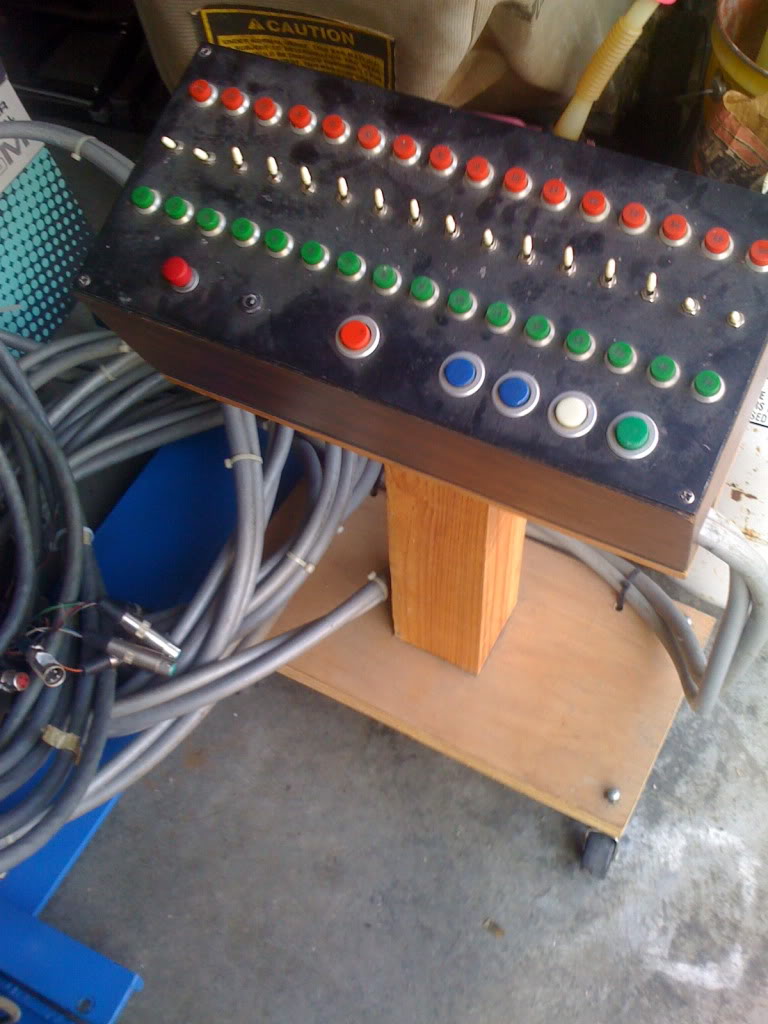

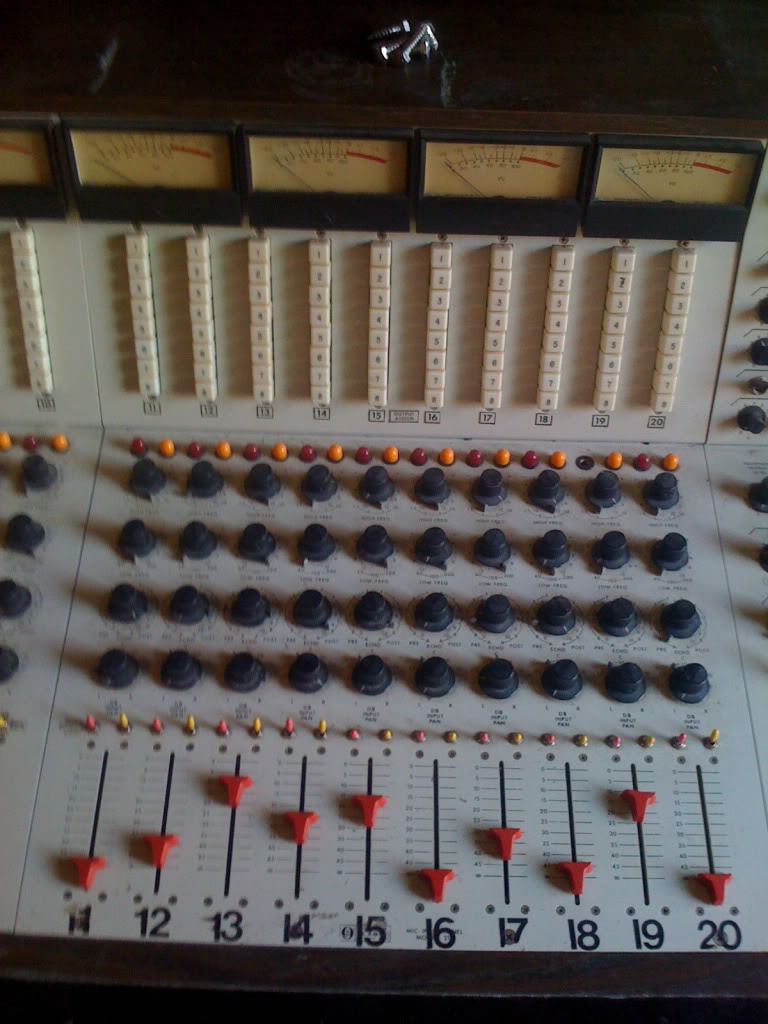
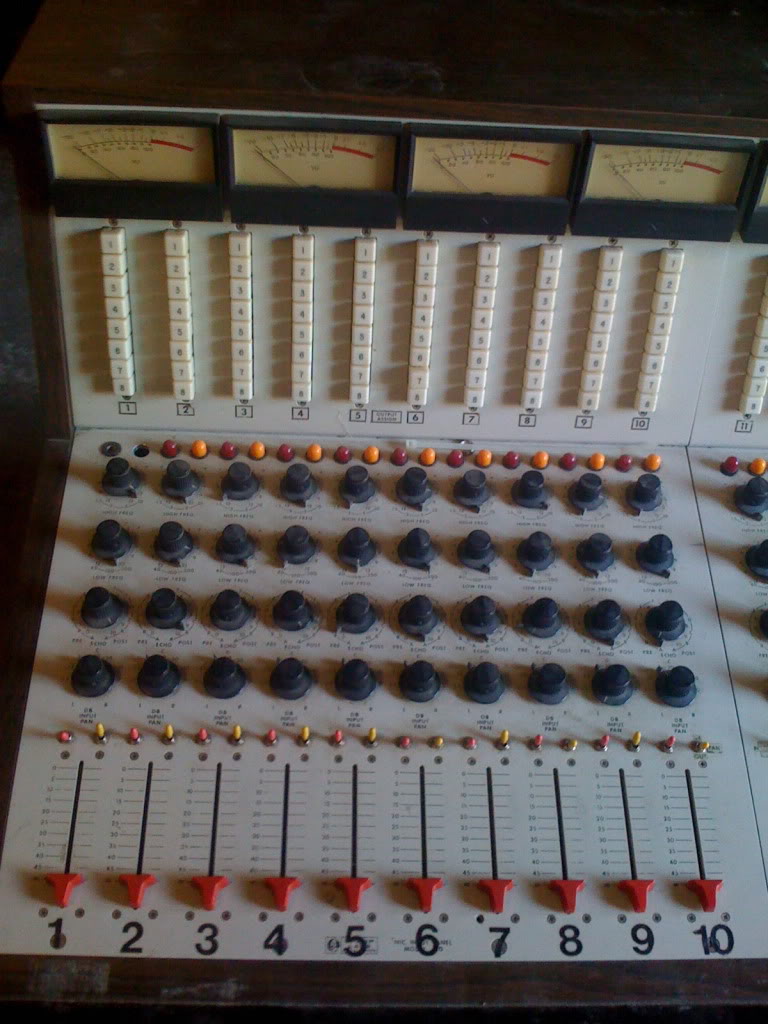
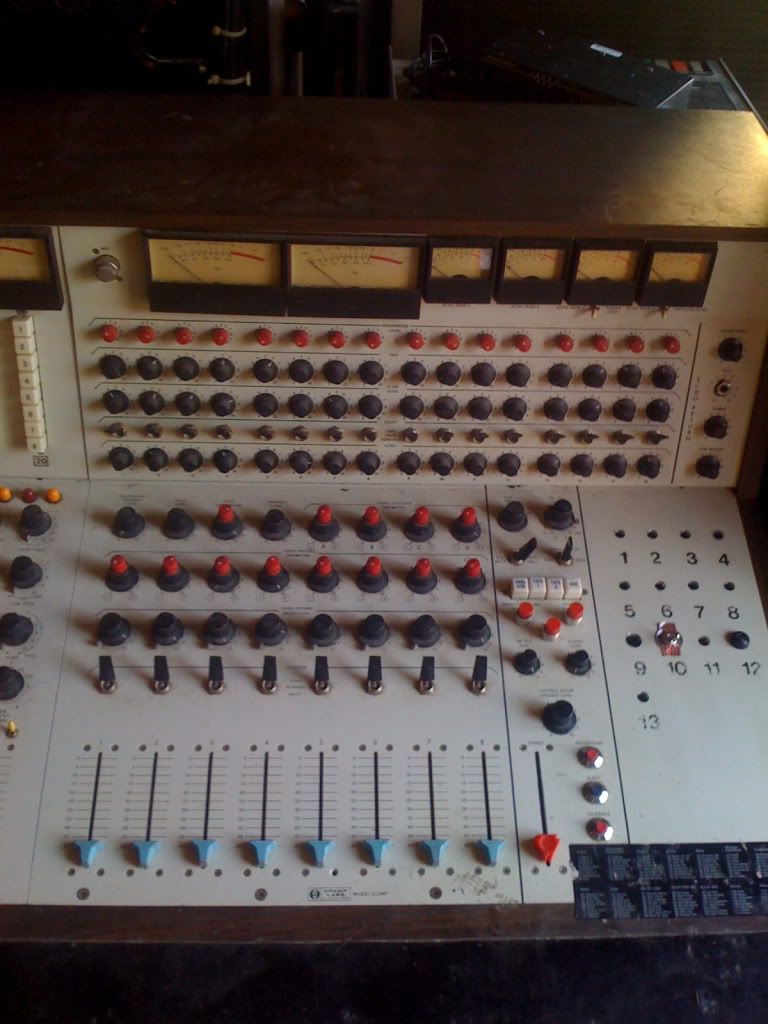
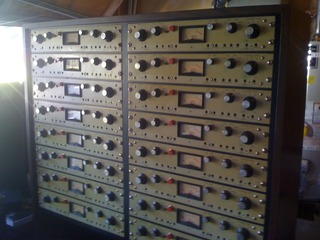
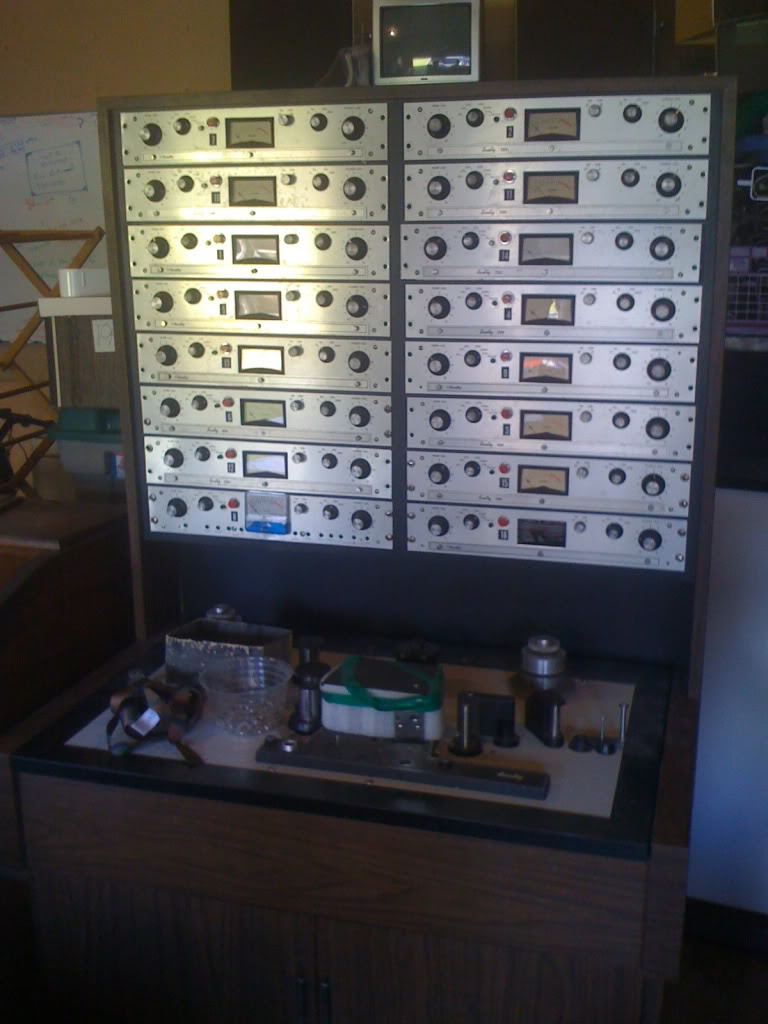

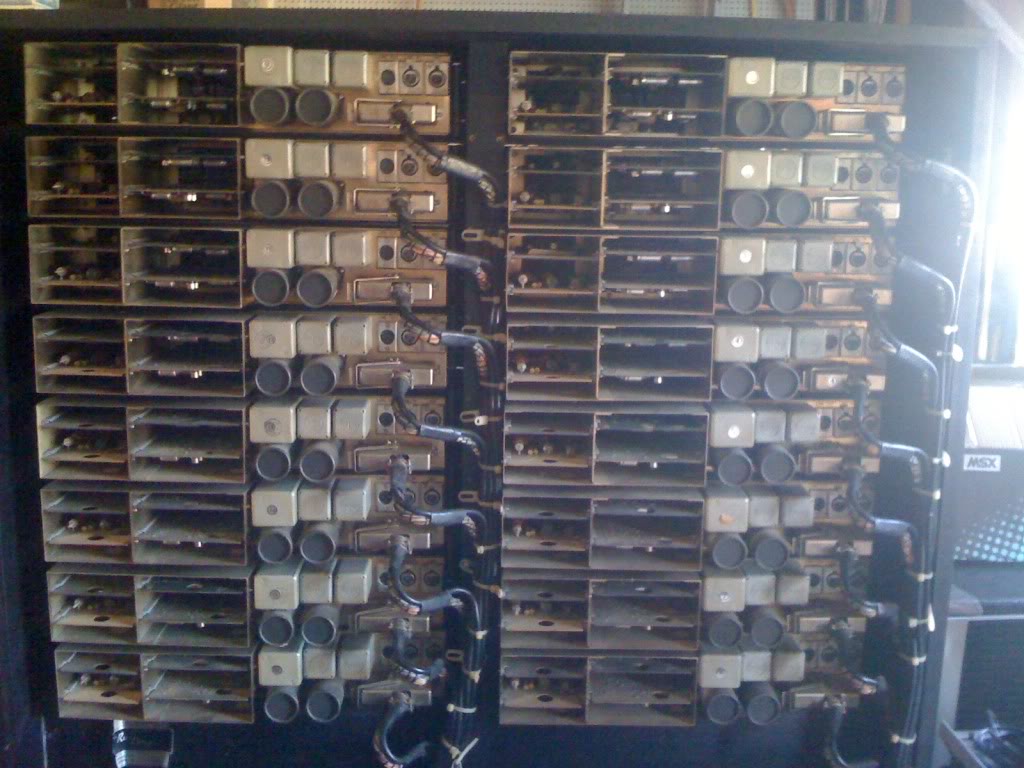
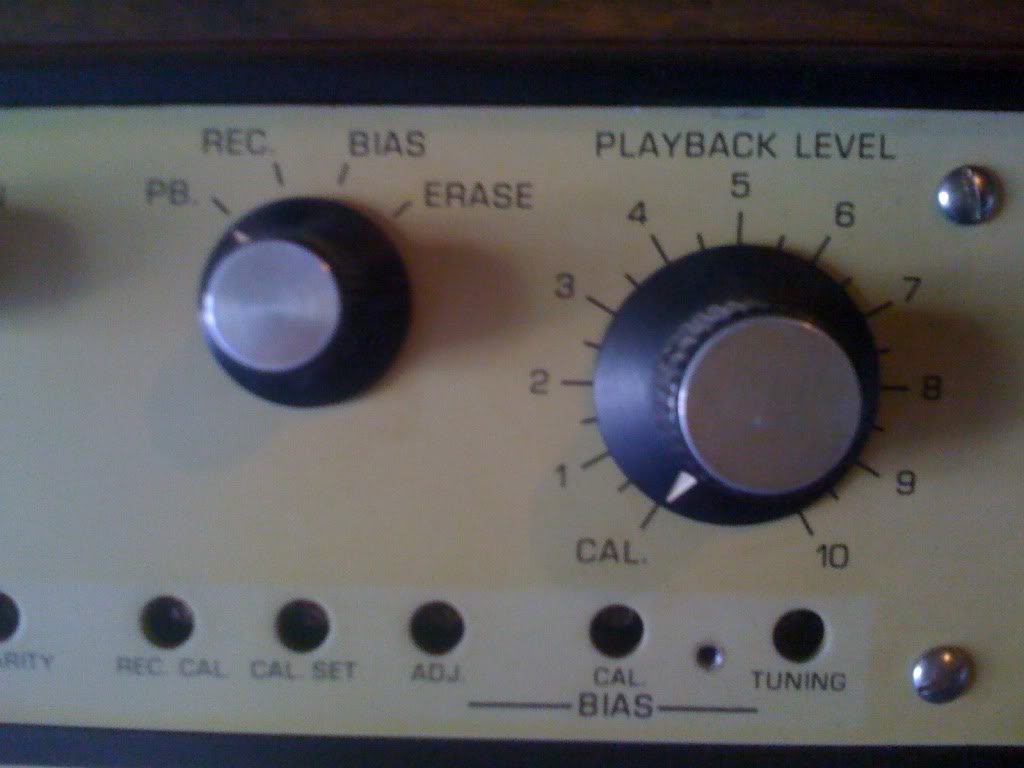
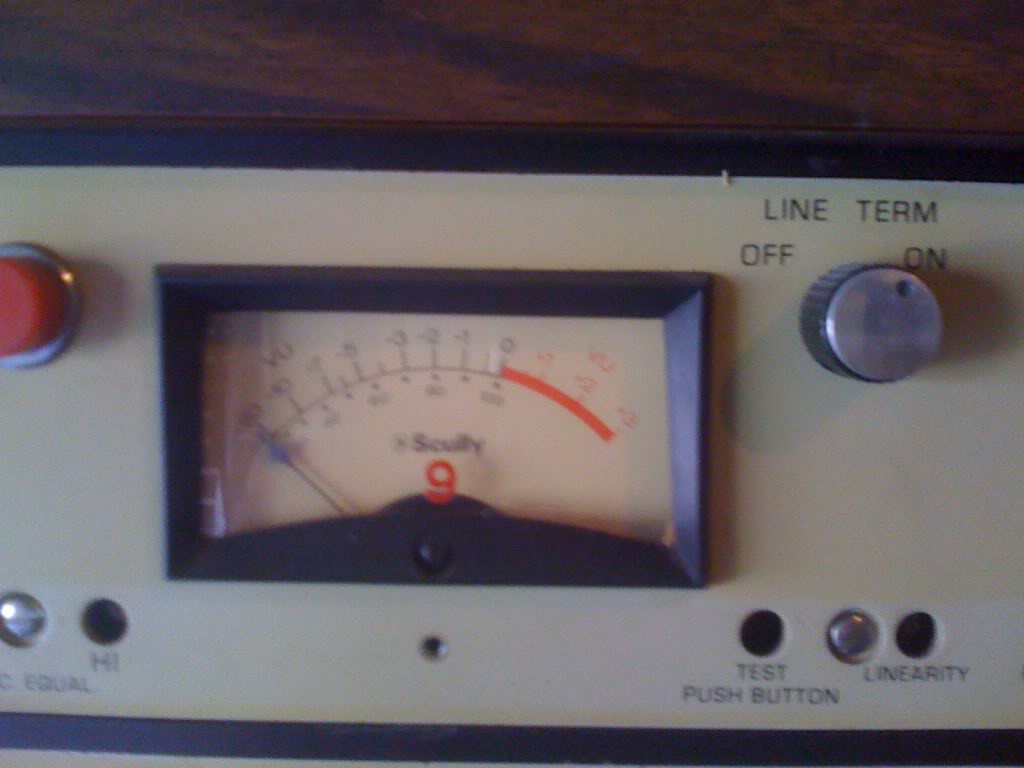




claymation So cool! I sure can as I assembled one, a 24 input v
claymation So cool!
I sure can as I assembled one, a 24 input version with 8 output buses. A stereo bus and 4 effects sends back in 1978.
I still own two thirds of that console. LOL! A lot of folks felt that they overloaded too easily. I didn't think so as I slightly changed my gain structure from what was recommended and we never had any overload problems. In fact, a beautiful replacement for an API or Neve console that few people know about. Their equalizer's were ferrite core inductors like Neve's. The microphone input transformers were the miniature Beyer's, but most of the great European microphones were designed into/around those transformers. Their integrated circuit chip the 409 as I recall, was one of the few to operate on +&-24 volts in comparison to most others 15 volt rails. This in combination with certain output buffering transistors made for one heck of a great sounding console with incredible headroom and low noise floor. It had a sweet fat sound that I still love to this day. I still have 10 inputs from that console and the master section that included 16 track monitoring. The microphone preamps were the 360 series. I have full documentation for that console, should you need it. The microphone preamps came in numerous different varieties. The 360BM, was the lowest noise version designed for integration within a console and was not designed to drive a 600 ohm load but had no problems loading into 10,000 ohms. From there, they had some higher current versions with a corresponding higher noise floor but able to drive lower impedance loads all the way up to 300 W DC operational amplifiers like a Crown Amplifier.
I believe the company is still in business at 1033 Sycamore Drive, Santa Monica California? They also make video distribution amplifiers and other systems. At the same location as the "Hollywood Dolly" company, in the same building as Record Plant and the former Delos Records. I think the son runs the company now since Bel Losmandy, owner/founder has most certainly retired? At least I haven't spoken to him since 1978. He is one of the fathers of integrated circuit chip technologies and made an integrated circuit chip that sounded way better than any 709/741, etc.. I keep 8 of those 360BM preamps regularly in-service and use them frequently. Great for tracking directly into a digital multitrack.
Enjoy your beautiful console as it sounds great! If you have any problems, don't hesitate to drop me a note.
Op-Amp Labs Lover and aficionado since 1978
Ms. Remy Ann David